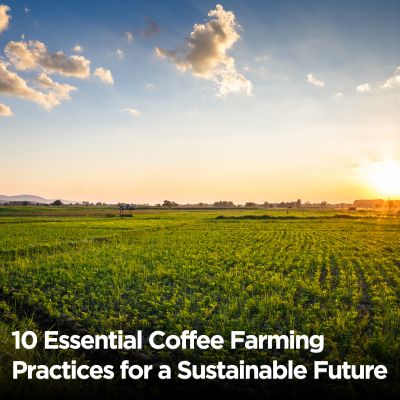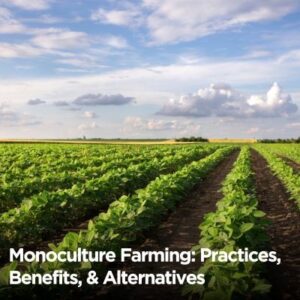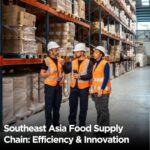Coffee farming is facing real pressure. Across producing regions, farmers are facing unpredictable weather, rising temperatures, and irregular rainfall.
These climate changes are already affecting how coffee grows, and in many areas, yields are going down while pests and diseases are spreading.
At the same time, years of soil depletion, water stress, and deforestation have taken a toll on the land. In many communities, farmers continue to face challenges, including low pay, limited support, and a lack of long-term stability.
All of this puts the future of coffee at risk. But there is a way forward. Coffee farming practices for a sustainable future are helping producers manage these challenges head-on.
By using better techniques and prioritizing both the environment and the people who cultivate the crop, farmers can protect their land, improve their harvests, and build stronger businesses.
For companies that depend on coffee, supporting sustainability at the farm level is no longer a choice. It is a practical step toward securing quality, resilience, and supply for the long run. In this blog, we’ll explore ten farming practices that are making a difference.
The Importance of Sustainability in Coffee Farming
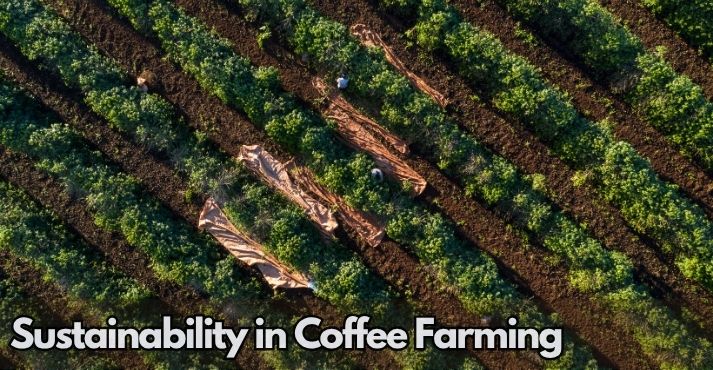
Sustainability in coffee farming is becoming essential for the future of the crop and the people who grow it. Many coffee farms are currently struggling with the effects of conventional farming practices.
Clearing forests to plant coffee, using excessive chemicals, and failing to allow the soil time to recover have all caused long-term damage. The land becomes less fertile, water is harder to manage, and entire ecosystems suffer.
Coffee farming has been linked to about 5% of global deforestation. That’s a big number for a single crop. When forests are cleared, it affects much more than just the trees.
Wildlife disappears, soil loses nutrients, and farms become more vulnerable to extreme weather. In the long run, this puts both yields and farmer incomes at risk.
This is where sustainable coffee farming practices come in. Simple changes, such as planting shade trees, rotating crops, or using natural compost, can make a significant difference.
These methods help the soil hold moisture, reduce erosion, and support biodiversity. They also help farmers achieve more consistent harvests, reducing their reliance on chemical inputs.
And it’s not just farmers paying attention. More consumers are asking where their coffee comes from and how it’s grown.
Many are choosing coffee that’s ethically sourced, which is prompting more businesses to consider sustainability from farm to shelf. Different types of coffee grown under better conditions often lead to higher-quality beans and better prices.
At the end of the day, taking care of the land is good for business. Sustainable farms are more productive over time, more resilient to climate change, and better positioned to meet future demand.
Sustainable Coffee Farming Practices
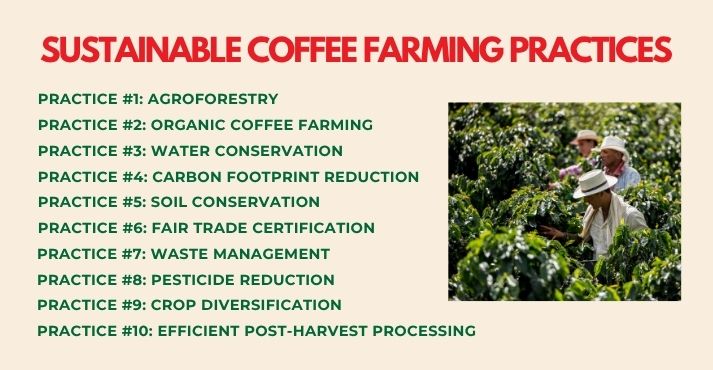
Below are ten eco‑friendly methods that farmers can use to build a more resilient and profitable coffee business. These practices support clean production and align with consumer demand for ethically sourced coffee in the food and beverage industry.
Practice #1: Agroforestry
Agroforestry involves planting shade trees and other plant species alongside coffee crops, creating a multi-layered canopy that supports soils and wildlife. This setup helps reduce erosion and keeps soils cool and moist, which can enhance the quality of Arabica coffee.
In Brazil’s Cerrado region, farms that mix coffee rows with native trees, such as mahogany and grasses like Urochloa, demonstrate stronger resistance to drought and fewer soil losses.
Their yields have improved without relying on chemicals, showing that an integrated system can be both productive and biodiversity-friendly.
Practice #2: Organic Coffee Farming
In organic coffee farming, compost, mulch, and natural pest controls are used to replace synthetic chemicals. This method preserves soil health and keeps nearby water sources cleaner.
One notable example is the Oromia Coffee Farmers’ Cooperative Union in Ethiopia. This farmer-owned cooperative grows organic coffee using bird-friendly, shade-grown techniques.
They follow fairtrade and organic standards, sell clean, flavorful beans abroad, and receive better prices while building trust with buyers.
Practice #3: Water Conservation
Water conservation is crucial in regions where coffee production strains already limited water resources. Techniques like drip irrigation, rainwater harvesting, and moisture sensors are becoming essential for long-term sustainability.
In Colombia, coffee producers are adopting innovative systems like the Ecomill®, which uses up to 80% less water than traditional methods.
These mills, combined with rainwater collection systems and more efficient irrigation, are helping farms use water more responsibly while maintaining high-quality bean production.
These eco-friendly solutions not only preserve valuable water but also help farms stay productive during dry seasons.
Practice #4: Carbon Footprint Reduction
Lowering greenhouse gas emissions can begin with simple innovations that have a significant impact. In Costa Rica and neighboring countries, small-scale coffee producers are installing solar coffee dryers to remove moisture from beans using clean, renewable energy sources.
This reduces fuel use, slashes costs, and makes the beans more attractive to buyers who care about environmental performance.
Projects in Central America supported by IICA and PROCAGICA have reported better bean quality and steady adoption of solar dryers among farmers seeking greener processing methods.
Practice #5: Soil Conservation
Healthy soil is essential for long-term coffee productivity. Techniques like crop rotation, composting, mulching, and using cover crops help restore nutrients, improve moisture retention, and reduce erosion.
In Brazil’s Cerrado region, farmers integrate Brachiaria grass between coffee rows. Studies have found that these cover crops increased soil carbon by nearly 28 grams per kilogram, thereby boosting overall nutrient levels and reducing the need for synthetic fertilizers.
These methods ensure long‑term soil fertility and support sustainable coffee growing methods.
Practice #6: Fair Trade Certification
Supporting fair wages and safe working conditions is growing in Fairtrade-certified organizations. About 38% of them now follow plans to adapt to climate challenges on the farm, reflecting a commitment to both social and environmental responsibility.
In Uganda, the Kibinge Coffee Farmers’ Co‑operative Society has benefited from Fair Trade agreements by gaining better pricing, cooperative support, and access to energy initiatives like solar-powered systems.
These improvements help support ethical coffee sourcing while enhancing farmer livelihoods and product quality.
Practice #7: Waste Management
Coffee processing produces massive amounts of byproduct — over 23 million tons of waste are created globally every year from coffee husks, pulp, and grounds.
In India, some farms are putting this waste to good use. One pilot initiative combines coffee pulp with cow dung in biogas digesters, which are then used to fuel farm machinery and produce nutrient-rich compost.
This waste-to-energy model is being explored as a cleaner solution to waste disposal. It cuts pollution, provides sustainable fuel, and supports sustainable agricultural practices in coffee.
Practice #8: Pesticide Reduction
Natural pest control is replacing widespread chemical use on many farms. In Vietnam’s Central Highlands, farmers working with Rainforest Alliance plant flowering strips along coffee plots and encourage nesting sites for beneficial insects like ladybugs and wasps.
These insects prey on pests, reducing the need for sprays and improving farm health, a core example of environmentally friendly coffee farming. The result is healthier ecosystems and lower costs associated with chemicals.
Practice #9: Crop Diversification
Planting food crops alongside coffee helps farms become more resilient, diversify income, and support ecosystem health.
In Kenya, many smallholder growers use a traditional agroforestry system known as shamba, where coffee trees are intercropped with bananas, beans, yams, and maize. The bananas provide shade and mulch, slowing down erosion, while legumes like beans enrich the soil with nitrogen.
This practice not only supports sustainable farming methods for coffee but can also increase farmers’ earnings by more than 50% over single-crop fields.
It’s a strong example of how mixing different crops, from robusta coffee to bananas and beans, can strengthen food security and farm income. This model supports rich coffee rituals worldwide, with farms supplying both local markets and export chains.
Practice #10: Efficient Post-Harvest Processing
Reducing water use during post-harvest processing helps protect local water sources, supports clean production, and preserves bean quality.
In Guatemala’s Jutiapa region, Gold Grains Coffee operates an ecological wet mill in Conguaco that recycles water through tanks and pumps.
This system uses less than 10 m³ of water per day to process up to 100,000 pounds of cherry, dramatically lower than traditional mills, and channels “honey water” byproduct into cattle pasture irrigation. That same leftover pulp is turned into compost, enriching both soil and local livestock systems.
These systems support better roast profiles and reduce environmental impact through resource efficiency.
How These Practices Benefit the Coffee Industry

Sustainable practices in coffee farming bring wide-ranging benefits across the industry. They help protect natural resources, improve coffee quality, and support the livelihoods of farmers and workers.
Certifications such as Fairtrade and Rainforest Alliance increase market value by signaling ethical production to buyers. For producers, meeting these standards creates access to premium markets and encourages longer-term, more reliable demand.
1. Long-Term Financial Benefits
By focusing on soil health, efficient water use, and waste reduction, farms consistently produce better beans that attract premium pricing. Higher-quality lots often score well during grading and cupping, giving producers more leverage when negotiating with specialty buyers.
In Peru, smallholder farmers in Fairtrade cooperatives, such as COCLA, have negotiated better pricing and improved terms, allowing them to reinvest in their farms and remain financially stable even during market volatility.
This success shows how green coffee farming techniques and certification lead to stronger business outcomes through traceability, higher quality, and a direct connection to buyers who value sustainability.
2. Environmental Impact
Smart resource management helps reduce deforestation, support biodiversity, and protect long-term farm productivity. Practices such as composting, shade growing, and cover cropping strengthen soil structure and reduce erosion.
More efficient irrigation systems are also making a big difference. For example, the Santa Helena farm in Brazil’s Cerrado region switched to drip irrigation and cut its water use by about 50% compared to conventional sprinklers.
In addition to conserving water, this system reduces energy costs and prevents runoff from carrying fertilizers into nearby forests and rivers, delivering real environmental benefits.
3. Social Impact
Fairtrade and similar certifications improve working conditions, wages, and community investment. These programs require premiums to be spent democratically on local development projects.
In Ethiopia, the Oromia Coffee Farmers’ Cooperative Union (OCFCU) used Fairtrade premiums to fund four health clinics and build 42 classrooms across its districts. These investments help retain workers and improve daily life.
Many roasters now feature origin stories during coffee cupping sessions to connect consumers with these community benefits and a sense of purpose behind every cup.
Conclusion
Sustainable coffee farming supports the long-term success of farms, local communities, and the natural environment.
Practices that protect soil, conserve water, and ensure fair working conditions lead to healthier crops, better yields, and stronger market opportunities. These efforts also help safeguard surrounding forests and water sources from harm.
Farmers can start small by using compost, planting shade trees, or improving water management. Over time, these changes improve coffee quality and build a more stable income.
Certification programs offer guidance and connect farmers to buyers who value ethical sourcing. With support from producers, roasters, and consumers alike, the coffee industry can grow in a way that respects both people and the planet.

